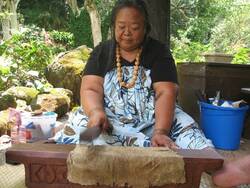Further Media
Producer unknown to us
Oceania, Polynesia, Hawai'i Archipelago (Owyhee/Big Island, Mau'i, Kaua'i o. Ni'ihau)
Before 1781
Breadfruit tree (Artocarpus communis J.R.Forst. & G.Forst.) or paper mulberry tree (Broussonetia papyrifera), nuts of the light walnut tree (Aleurites moluccana), berries of the Dyer's fig (Ficus tinctoria G.Forst.), leaves of the bowlwood tree (Cordia subcordata)
Acquired in 1773–74 or 1777 on Captain James Cook’s second or third expedition in the Pacific. It is yet unknown by whom the object was acquired.
Brought from Great Britain to Germany by Benjamin La Trobe, a Moravian working in London.
Inv. no. 68674
The making of bark bast (kapa) was a sacred act never performed in public. Instead, the women, who were the only ones to manufacture kapa, gathered in a secluded place and locked their kapa workshop to prevent the chatty men from entering. Their talk was considered pernicious for the arrowroot glue, with which the smaller kapa rectangles were glued together into seemingly endless webs of fabric.
Above all, however, the women made spiritual contact with Lauhuki, the goddess of bark bask making and 'Ehu, the goddess of kapa dyeing. Inspired by the goddesses, accompanied by the rhythmic, hours-long knocking of kapa clubs, which flattened the bark bast of younger tree branches soaked in water, felted together and turned it into rectangular pieces of fiber fleece, materials were obtained that preserved and enlarged mana – the divine energy of the ancestors.
Colorfully decorated bast fabrics, such as the three-colored bark bast in the Herrnhut Cook collection, were destined for the noble caste (ali’i) – an aristocratic status symbol to which the lower caste in Polynesia were not entitled. Fabric quality, coloring, and design made clear the individual rank, origin, and genealogy of an ali’i.
The use of red – sacred – color on kapa corresponded with the gods, whom the leaders of Hawai'i (ali’i nui) considered their ancestors. The red color pigments were extracted in a complex process from the berries of the dyeing fig (mati) and the leaves of the bowl tree (kou). The black color was made from the soot mass of burnt light nuts (kukui) and light nut oil, which was also used for tattooing the skin.
